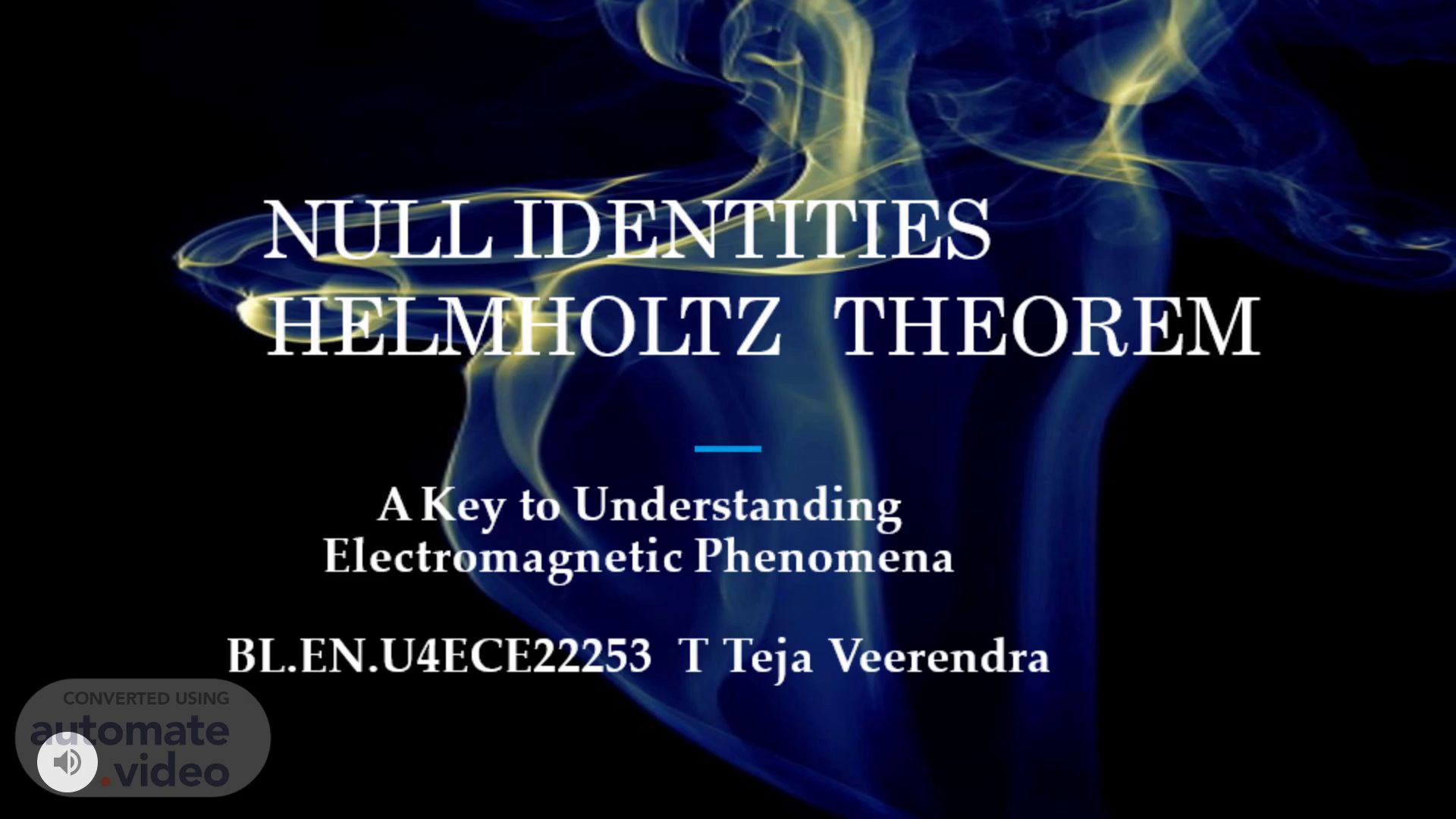
Page 1 (0s)
[Audio] NULL IDENTITIES HELMHOLTZ THEOREM A Key to Understanding Electromagnetic Phenomena BL.EN.U4ECE22253 T Teja Veerendra.
Page 2 (1s)
[Audio] Content Introduction to Helmholtz's Theorem Introduction to Vector Fields Components of Helmholtz theorem Interpretations of Helmholtz Theorem Application of Helmholtz's Theorem Practical Implications of Helmholtz's Theorem Conclusion.
Page 3 (15s)
[Audio] Helmholtz's Theorem- Uniquely Decomposing Vector Fields Helmholtz's theorem in the context of vector fields Its applicability to diverse scientific and engineering disciplines Revolutionizing the analysis of physical phenomena and engineering systems Practical implications in fluid dynamics and electromagnetism Formula-F(r)=−∇ϕ(r)+∇×A(r).
Page 4 (39s)
[Audio] Historical Background Hermann von Helmholtz, 19th-century German physicist Mid-19th century formulation of Helmholtz's Theorem Provided a systematic approach to analyze complex vector phenomena Fundamental tool in fluid dynamics, separating rotational and irrotational flow Applied in electromagnetism for understanding magnetic vector fields.
Page 5 (1m 1s)
[Audio] INTRODUCTION Vector fields are a fundamental concept in various scientific and engineering disciplines, representing quantities such as velocity, force, and electromagnetic fields in three-dimensional space. Understanding vector fields is crucial for analyzing physical phenomena and engineering systems..
Page 6 (1m 22s)
[Audio] Statement of Helmholtz's Theorem Helmholtz's theorem states that any sufficiently smooth, rapidly decreasing vector field in three dimensions can be uniquely decomposed into the sum of an irrotational (curl-free) vector field and a solenoidal (divergence-free) vector field..
Page 7 (1m 40s)
[Audio] Components of Vector Fields The decomposition of a vector field into its irrotational and solenoidal components allows us to understand the behavior of the field more intuitively. The irrotational component represents the part of the field that circulates around points without any net rotation, while the solenoidal component represents the part that flows into or out of points without any net accumulation..
Page 8 (2m 5s)
[Audio] Physical Interpretation Solenoidal component: Represents the source or sink behavior (e.g., fluid divergence) Irrotational component: Describes the swirling or rotational aspects (e.g., fluid vorticity) In electromagnetism, the irrotational component corresponds to the electric potential, while the solenoidal component represents the magnetic field..
Page 9 (2m 31s)
[Audio] Applications in Fluid Dynamics Helmholtz's Theorem applied to study and comprehend fluid behavior Provides a systematic approach for breaking down and analyzing complex fluid flow patterns.
Page 10 (2m 45s)
[Audio] Helmholtz Theorem for Electromagnetism Essential tool for analyzing complex electromagnetic fields Facilitates a comprehensive understanding of the behavior of electric and magnetic fields Separation of Electric Potential and Magnetic Field- Decomposition in Electromagnetic Context: Helmholtz's Theorem applied to electromagnetic fields Separation into electric potential (irrotational) and magnetic field (solenoidal) components.
Page 11 (3m 13s)
[Audio] Application in Electromagnetism Analyzing and interpreting electromagnetic fields Separation of electric potential and magnetic field Understanding electromagnetic phenomena Practical implications in engineering and technology.
Page 12 (3m 27s)
[Audio] Applications in Signal Processing Fundamental Signal Breakdown: Helmholtz's Theorem applied to signal processing Allows decomposition of signals into distinct irrotational and solenoidal components.
Page 13 (3m 42s)
[Audio] Applications in Signal Processing Precision in Signal Manipulation: Utilizing Helmholtz's Theorem for targeted manipulation of signal components Enhances the ability to analyze and modify specific aspects of signals with precision.